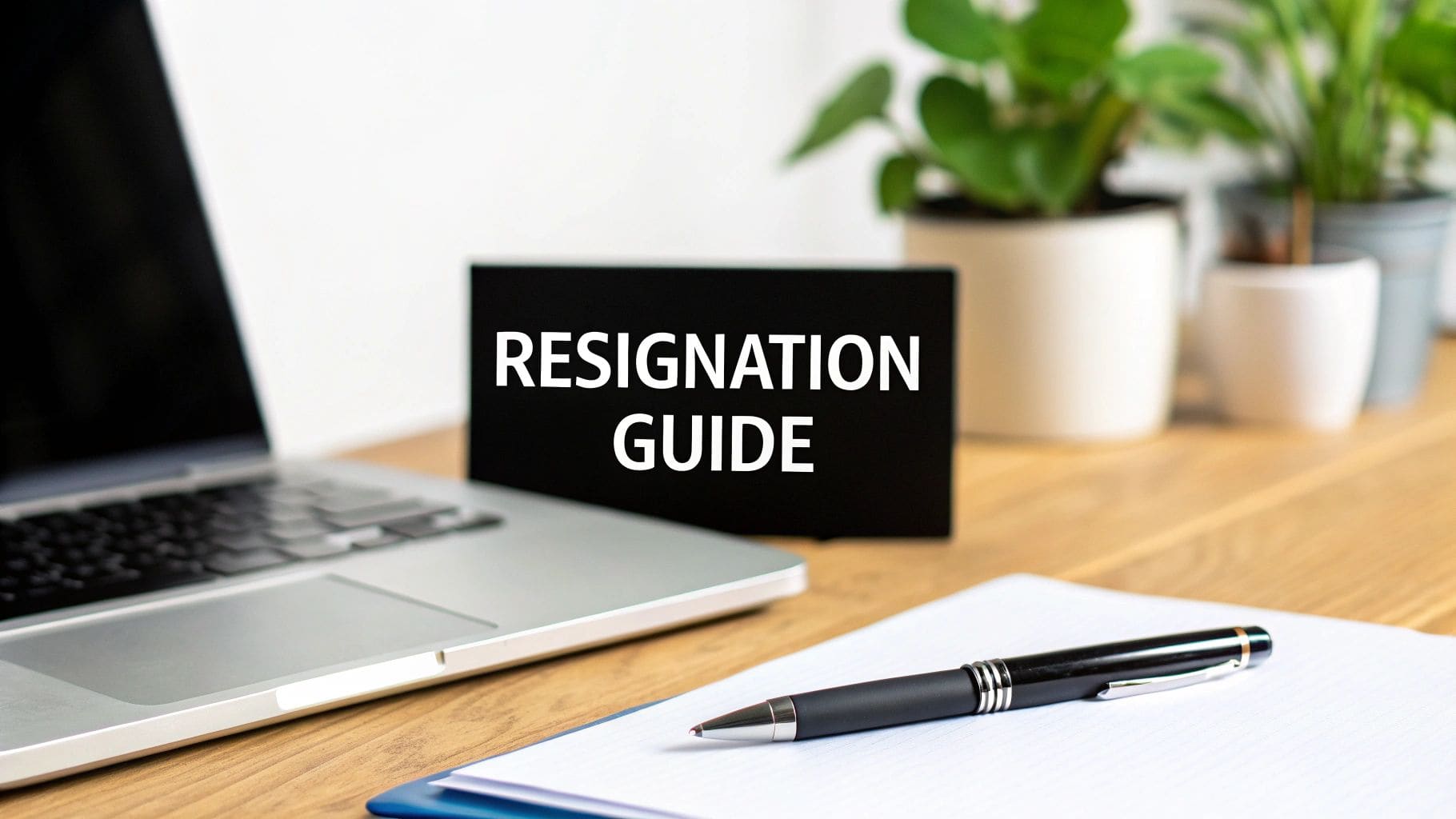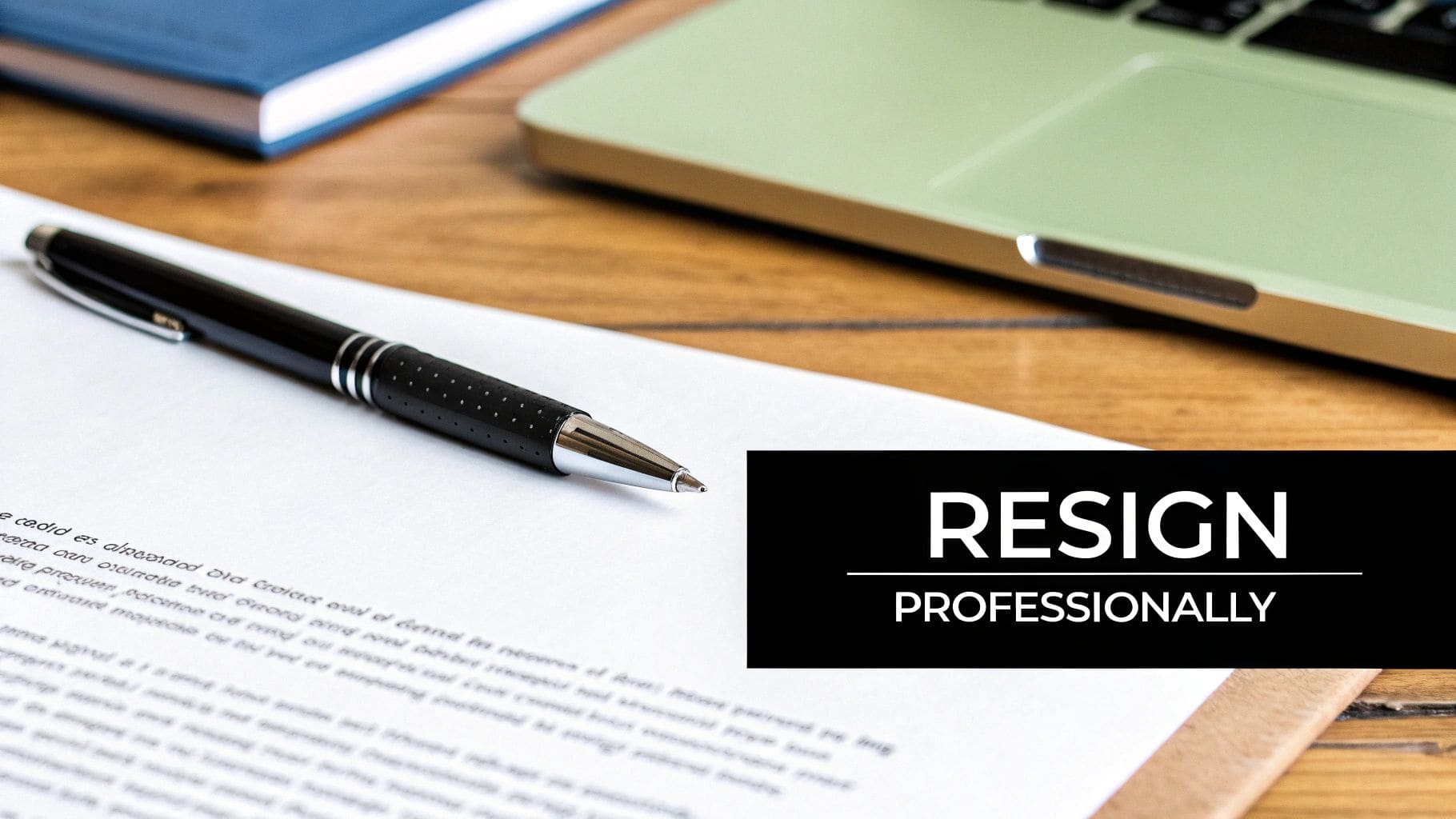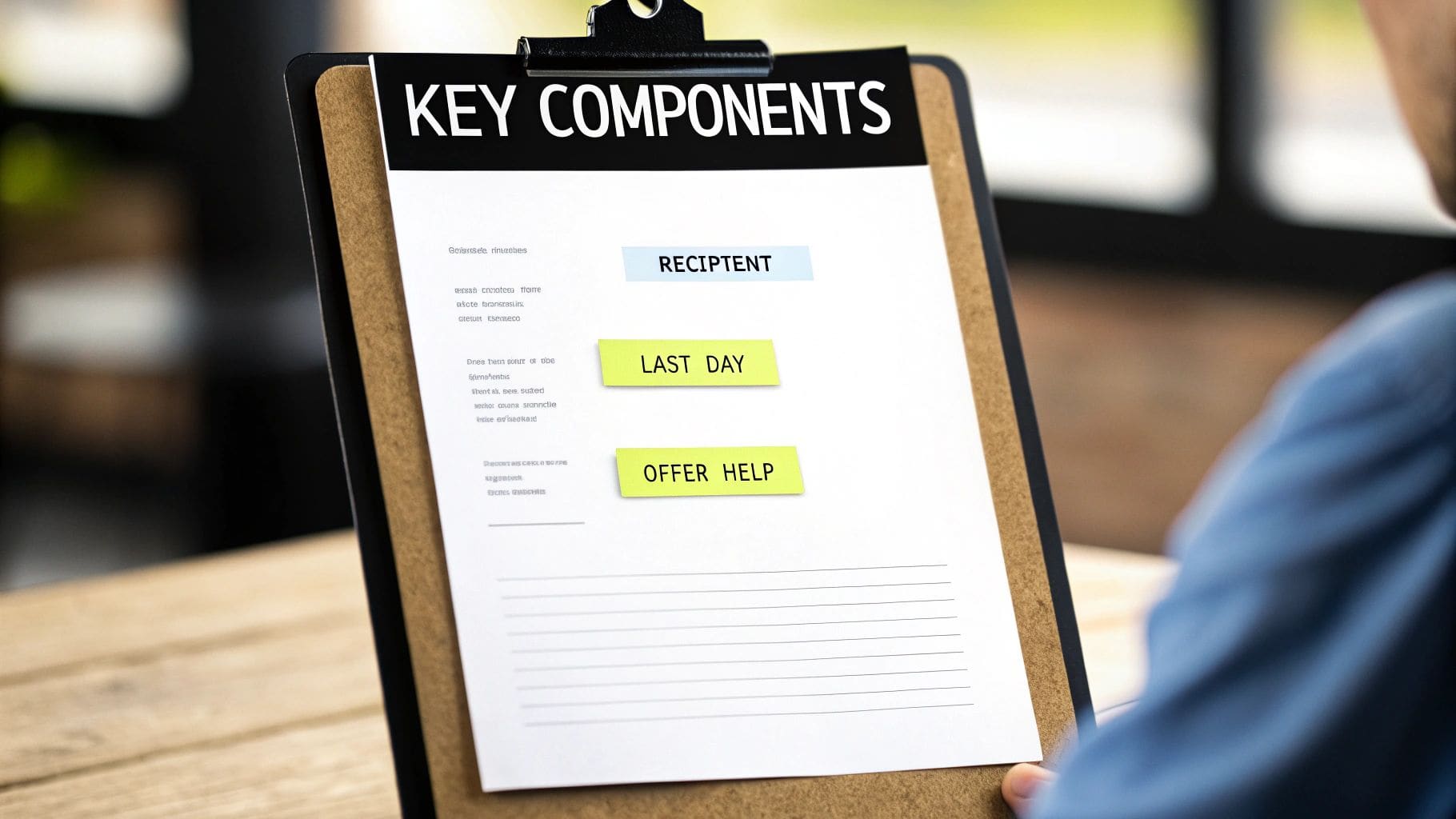How to Write a Professional Resignation Resign Letter
Craft a professional resignation resign letter with our expert guide. Get actionable tips, real-world templates, and advice for a smooth, positive exit.

How to Write a Professional Resignation Resign Letter
Writing a professional resignation resign letter is the last critical step to leaving your job on good terms. A strong letter is straightforward: it includes a direct statement that you're resigning, your final day of employment, and a brief, polite closing. This guide will walk you through how to strike the right tone to make sure your departure is seen as graceful, keeping the door open for future opportunities and securing those all-important positive references.
Why Your Resignation Letter Matters

This letter is the official, written record of your departure. Its main job is to formally tell your employer you're leaving and to set a clear timeline for your exit. It's a simple document, but it does some heavy lifting behind the scenes.
For one, it creates a paper trail, confirming the date you gave notice. This protects both you and the company from any confusion down the line. It also solidifies your professionalism, ensuring you leave on a high note—something that's absolutely vital for future references.
Finally, this letter is the starting gun for the transition process. It's the official signal to your manager that they need to start thinking about your replacement and how to hand over your duties.
The Modern Way of Moving On
The workforce has never been more mobile. We've all seen the ripple effects of the Great Resignation, which kicked off in 2021 and saw millions of employees leave their jobs for better pay, growth, and a healthier work-life balance.
This trend is still going strong, with people continuing to seek out better company cultures and more flexibility. In this dynamic environment, mastering the art of the resignation letter isn't just a good idea; it's an essential career skill.
A great resignation letter isn't about explaining why you're leaving; it's about confirming how you're leaving—with professionalism, respect, and a focus on a smooth transition.
Setting Yourself Up for a Smooth Exit
Before you even start writing, take a moment to review your original employment contract with details about notice periods. You'll want to double-check the required notice period to make sure you're meeting all your contractual obligations. Two weeks is standard, but some roles require more.
Your letter sets the tone for your final weeks on the job. It's the formal kickoff to a process that will include wrapping up projects, training your replacement, and saying goodbye to your team. Remember, this document should always follow a verbal conversation with your manager; it's the official record, not the conversation itself.
This kind of professional communication is key at every stage of your career. For a similar perspective on making a great first impression, you might find our guide on how to write a compelling cover letter to secure a new job helpful.
Resignation Letter Do's and Don'ts
To keep things simple, here's a quick cheat sheet. Sticking to these guidelines will help you maintain a positive and professional relationship as you transition out of your role.
| Do | Don't |
|---|---|
| Keep it concise and to the point. | Go into a long explanation of why you're leaving. |
| State your last day of employment clearly. | Use emotional or negative language. |
| Offer to help with the transition. | Complain about the company, your boss, or colleagues. |
| Express gratitude for the opportunity. | Make promises about the transition you can't keep. |
| Proofread it carefully before sending. | Forget to provide your contact information. |
Following these simple rules ensures your final official communication is polished, professional, and leaves a lasting positive impression.
Get your free CV review
Upload your CV and get instant AI suggestions tailored to your industry
Key Components of a Professional Letter

Think of your resignation letter as more than just a quick "I quit." It's the formal handshake that closes out your time with a company, and each part plays a specific role in leaving a polished, professional final impression.
Your letter should start with the basics: your contact information and the date, followed by your manager's details. Always, always address it directly to your immediate boss. Sending a blind email to HR without looping in your manager first is a classic misstep that can create unnecessary friction.
From there, the opening statement needs to be direct but polite. You want to get straight to the point without sounding cold or abrupt.
The Core Message
The body of the letter is where the most critical information lives. You have to clearly state that you're resigning and, just as importantly, specify your last day of employment. Any ambiguity here is a recipe for confusion with payroll and your team.
For example, a simple and effective line is: "Please accept this letter as formal notification that I am resigning from my position as [Your Title], effective two weeks from today's date, [Date]." There's no room for misinterpretation there.
Another key component is offering to help with the transition. You don't need to make promises you can't keep, but a simple statement showing your commitment to a smooth handover demonstrates goodwill. Managers always appreciate this.
A well-structured resignation letter is less about your reasons for leaving and more about managing your exit professionally. It's a strategic tool for maintaining positive relationships that can benefit your career for years to come.
Your closing should be just as professional as the opening. A simple "Sincerely" or "Best regards," followed by your signature, is all you need. Remember, this is a business communication, not a personal note, so keep the tone consistent.
The structure is a lot like other formal business documents. If you're looking for a refresher, reviewing examples of effective cover letters with proper formatting can be a great way to see how to properly structure this kind of correspondence. This final touch reinforces your professionalism and ensures your letter concludes on a positive note, securing your reputation long after you've moved on.
Resignation Templates for Any Situation
Every resignation is unique, and your letter should absolutely reflect that. A generic, copy-paste approach just feels impersonal and can leave the wrong impression. The real goal is to write a clear, professional, and situation-aware letter that keeps your relationship with your soon-to-be-former employer on solid ground.
If you're wondering about the basic structure, it often mirrors other types of professional letters. In fact, getting a feel for how tone and format shift in different contexts can be a big help. You can see this in action by looking through different cover letter examples and templates for inspiration; it's all about adjusting your message for the right audience and purpose.
The Standard Professional Resignation
For most departures, a straightforward and formal letter is your best bet. This is the template to use when you need to be direct, polite, and cover all the necessary bases without getting into too much detail. It's perfect when your relationship with your manager is professional but not deeply personal.
Example:
Dear [Manager's Name],
Please accept this letter as formal notification that I am resigning from my position as [Your Job Title] at [Company Name]. My last day of employment will be [Your Last Day], which is two weeks from today.
I'm grateful for the opportunity to have worked here for the past [Number] years. I am fully committed to ensuring a smooth transition during my final two weeks. Please let me know how I can best assist in handing over my responsibilities.
Sincerely, [Your Name]
This example just works. It's clean, professional, and leaves no room for ambiguity. It clearly states your intention and final day, offers help with the transition, and includes a brief, polite note of gratitude. It's a safe and respectful option for almost any situation.
The Appreciative Resignation
Sometimes you're leaving a job you genuinely loved, with a team and manager you respect deeply. When you've had a long, positive run and built strong relationships, a slightly warmer, more personal tone is not just appropriate—it's the right thing to do.
This template adds a layer of specific gratitude, which goes a long way in maintaining those valuable connections for the future.
This screenshot from Wikipedia shows a classic example of how to structure a simple resignation letter. The format is clean and professional, which is the foundation of any effective notice.
Notice how it emphasizes clarity and gets straight to the point. That's always your starting block.
Example:
Dear [Manager's Name],
I'm writing to inform you that I will be resigning from my role as [Your Job Title], with my final day being [Your Last Day].
I want to express my sincere gratitude for the opportunities you've given me during my time at [Company Name]. I've truly valued my time here and am especially thankful for your mentorship on projects like [Specific Project]. That experience was invaluable.
I wish you and the company all the best and am more than happy to help ensure a seamless handover of my duties.
Best regards, [Your Name]
Common Resignation Mistakes to Avoid
How you write your resignation letter says a lot about you, and its impact can follow you long after you've left the building. It's tempting to use this letter as a final word on all your frustrations, but trust me, that's a huge mistake.
Venting about your boss, your team, or your workload might feel incredible in the moment. But it's a short-term win that can permanently burn bridges, costing you a valuable reference or a future opportunity down the road.

This is more important than ever. With global employee engagement on a steady decline, a lot of people are unhappy. Dissatisfaction with management is a massive driver, with 50% of employees pointing to their manager as a reason for quitting. You might feel completely justified, but a negative resignation letter only makes you look unprofessional. You can read more about this in Gallup's State of the Global Workplace report on employee engagement.
Keeping Your Reasons Private
Another classic mistake is oversharing. Your letter is not the place to announce your amazing new job, brag about your new salary, or list every single reason you're leaving. Tossing in too much detail can come across as unprofessional, or even a little boastful.
Just stick to the essentials:
- Your clear intention to resign.
- Your last day of employment.
- A brief, positive sign-off.
Overly detailed resignation letters often create more problems than they solve. Simplicity is your ally; it keeps your message professional, clear, and focused on a smooth exit.
On that note, how and when you deliver the news is just as critical. Your direct manager should be the very first person to know you're leaving—ideally in a face-to-face chat before you hand over the letter. Letting them find out through office gossip or a surprise email from HR is disrespectful and can instantly sour a relationship you've spent years building.
By sidestepping these common pitfalls, you make sure your departure is handled with grace and professionalism. Your final act should reinforce your value as a thoughtful employee, not tear it down. A carefully written letter protects your reputation and keeps your professional network strong.
Managing Your Final Weeks With Professionalism
Once you've handed in your resignation letter, the game isn't over. In fact, how you manage your final weeks can be just as important as the work you did for the past year. This isn't the time to coast; it's your chance to leave on a high note and make the transition as smooth as possible for the team you're leaving behind.
Honestly, people often remember your exit more vividly than your day-to-day work. The best way to make a great final impression is to create a simple transition document. This doesn't have to be a novel—just a clear guide covering your key projects, important contacts, and where to find essential files. It's a small effort that speaks volumes about your professionalism.
Handling Your Departure Gracefully
Your exit interview is another key moment. Think of it as an opportunity to offer constructive, positive feedback, not a chance to vent about every little thing that ever annoyed you. Sensitive topics can come up in these final conversations. Knowing how to handle difficult conversations at work will help you keep things respectful and professional right to the very end.
It's a common move these days—skilled professionals are always looking for the next right step. In Europe alone, around 36% are thinking about changing employers in 2025 as their priorities shift.
Final impressions last. Your goal is to leave colleagues and management with a positive memory of your contributions and professionalism, solidifying your reputation for future opportunities.
Finally, make sure to say proper goodbyes. You don't need a grand farewell tour, but a thoughtful note or a quick chat with the colleagues you worked with closely goes a long way in maintaining your professional network.
As you move on, keeping all your new contacts and applications in order is crucial. Using a simple job application tracker to stay organized can help you manage your next steps without missing a beat. This ensures that even after sending that resignation resign letter, you keep your career momentum going strong.
Frequently Asked Resignation Questions
Once you've decided to move on, a few common (and sometimes tricky) questions always pop up. Let's tackle them head-on.
The classic two weeks' notice is standard practice for a reason—it's generally enough time for a smooth handover in most roles. However, if you're in a senior position or a highly specialized role, you might want to consider giving more time. Think about your contract and the impact your departure will have on current projects. The goal is to leave on good terms, not to leave your team in a lurch.
Another big one: should you resign in person or is an email okay? An in-person conversation with your manager is almost always the best way to go. It's respectful and professional. Follow that chat up immediately with your formal resignation resign letter via email. This one-two punch of personal conversation and written confirmation is the gold standard. If you're remote, a video call is the next best thing to being there in person.
What If I Am Leaving for Negative Reasons?
This is a tough spot, but the advice is simple: keep it out of your letter. You are never obligated to detail your reasons for leaving, especially if they're negative.
When you're leaving under less-than-ideal circumstances, your letter should remain positive and neutral. Focus on thanking the company for the opportunity and stating your commitment to a smooth transition. Save your grievances for a confidential exit interview—if you choose to share them at all. Your resignation letter is a permanent record, and burning bridges serves no one.
This handy decision tree breaks down the key actions to take after you've hit "send" on that letter, helping you navigate your final weeks like a pro.
As the visual shows, your focus should shift from your day-to-day tasks to ensuring a seamless handover for your replacement. This means documenting processes, participating constructively in exit interviews, and preserving the professional relationships you've built. Handling these final steps with grace is just as crucial as writing a great resignation resign letter.
--- Ready to make your next career move with confidence? The tools at CV Anywhere help you build a standout CV, track applications, and ace interviews all in one place. Start building your future with CV Anywhere today.
Tags
Related Articles
How to Write a Letter for Resignation Letter
How to Write a Letter for Resignation Letter Writing a professional letter for resignation letter is the final, crucial step in leaving your job. It's more than just a formality; it's the official doc...
Read more →Your Professional Letter of Resignation Letter Guide
Your Professional Letter of Resignation Letter Guide Crafting a professional letter of resignation letter is more than just an official notice—it's your last formal impression. This strategic document...
Read more →How to Write a Professional Resignation Letter
How to Write a Professional Resignation Letter A professional resignation letter is the official document that begins your departure from a job, serving as your final professional handshake. Its prima...
Read more →Popular Articles
A solid cv uk template is the bedrock of any successful job hunt in the UK. Think of it less as a fill-in-the-blanks document and more as a professional, recruiter-approved framework. The right one en...
The simplest way to think about a curriculum vitae is that it's the full, exhaustive story of your professional and academic life. It's not a summary; it's the whole book. Unlike a punchy, one-page re...
Applicant Tracking Systems (ATS) are the gatekeepers of modern recruitment. To ensure your application makes it to a human, you must avoid the most common ats cv mistakes that cause these systems to m...
Following the correct US resume formatting rules is the first step toward impressing American hiring managers. It's about presenting your career story in a clean, scannable way that recruiters—and the...
A powerful job application tracking spreadsheet is your secret weapon, turning the chaos of a job hunt into a strategic, organised campaign. Think of it less as a simple list and more as a dynamic com...